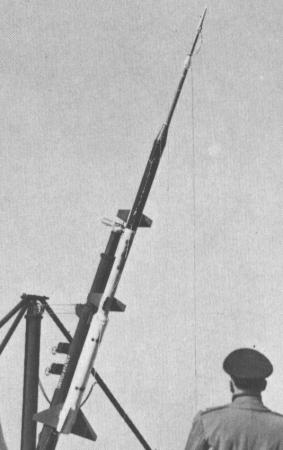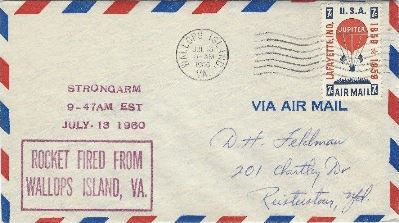Space Cover 466: StrongarmWhat is more fun than launching a rocket? "Mash" together five rockets and launch the combination multiple times!
Starting in the 1950's there was an interest in obtaining detailed information on the distribution of free electrons in the. Scientists wanted information on the distribution of free electrons in the vicinity of the "F2" atmospheric layer maximum (an altitude of approximately 185 miles and beyond).
A trajectory comparison method for obtaining electron densities from Doppler Velocity and Position (DOVAP) data was devised at the Ballistic Research Laboratories as early as 1950. In this method, the DOVAP trajectory obtained for a rocket flight was compared with a vacuum trajectory. A small program was initiated at the time to obtain electron density data from V-2, Viking, and Bumper rounds fired at White Sands Missile Range. The V-2 and Viking rounds attained altitudes ranging from 100-150 miles, while one of the Bumper rounds (Bumper V) reached an altitude of 250 miles. Fragmentary electron density data were obtained from these firings. At the close of the International Geophysical Year (December 31, 1958), the IGY rocket firings were screened, and it appeared that the DOVAP data from approximately twenty-five of the firings might be suitable for electron density reduction purposes. Closer examination reduced the number of suitable rounds to ten, three being Nike-Cajuns, six Aerobee Hi's, and one a Sparrowbee. The Nike-Cajuns and Aerobee-Hi's attained altitudes ranging from 80-120 miles, while the Sparrowbee reached 175 miles.
Good electron density data were obtained from these rounds. However, only one round approached the F2 maximum. Therefore, it was decided that a further effort should be made to measure electron density profiles in high altitudes.
A new solid propellant rocket combination, known as the Strongarm, was assembled for this purpose by the University of Michigan under contract to the Ballistic Research Laboratories.

This rocket combination consisted of five rocket stages:
- Honest John
- Nike
- Nike
- Yardbird
- Scaled-down Sergeant
The Strongarm was used by the Army with a payload to measure the electron density in the upper atmosphere at altitudes of more than 1000 miles. The highest apogee reached was 1260 miles. Seven electron density missions were flown by the Army until 18 February 1961. The flights occurred on November 10 and 18, 1959; July 13 and 14, August 2, 1960; and February 14 and 18, 1961. These flights were all launched from Wallops Island.
The USAF also launched a single Strongarm on July 27, 1961, this time the launch was from White Sands Missile Range. This rocket was of modified configuration, using a higher-thrust Thiokol Recruit fourth stage and no fifth stage.













